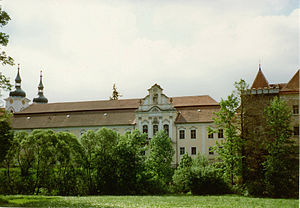Želiv Monastery
Monastery Želiv (German: Seelau or Selau ; Latin: Siloe ) is a Premonstratensian abbey in the village of the same name Želiv in Okres Pelhřimov in the Czech Republic . In its early years it was a Benedictine monastery .
history
The Želiv monastery was founded in 1139 on a spur above the Želivka as a subsidiary of the Sazau Benedictine abbey . As a Benedictine monastery, it only existed for a few years. Together with the surrounding area, Želiv village and monastery came into the possession of the Prague bishops in 1144.
On the initiative of the Olomouc bishop Heinrich Zdik and with the consent of the Prague bishop Daniel I , the monastery was settled in 1148–1149 with Premonstratensian canons from Steinfeld monastery in the Eifel , from whose ranks the first abbot Gottschalk came.
Soon other monasteries were established from Želiv. There were the men's monasteries Geras (1153) and Mühlhausen (1187) as well as the women's monasteries Launiowitz (1149/1150), Pernegg (1153) and Rosa Coeli monastery in Kanitz (1181), whose first women choirs also came from Steinfeld.
The abbey had extensive property over which it also exercised the right of patronage . In 1233 the monastery acquired the Humpoletz estate from the Teutonic Order , as well as the patronage rights over this and over Iglau .
After a fire, the monastery was rebuilt in 1374. It was sacked in the Hussite Wars in 1420 and 1424. As the abbots had fled to Jihlava, the Bohemian King George of Podebrady gave the monastery property to the noble family Trčka von Leipa in 1468, who owned it until 1599. The papal legate for Bohemia and Hungary, Cardinal Paul, approved the monastery in 1502 to receive the parish income and the appointment of religious to pastors. After the Battle of the White Mountain , Želiv's goods were confiscated . In 1623 the Premonstratensians of Strahov Abbey were able to buy back the former monastery property for their order. In 1643 the Selau monastery became independent again, but suffered damage from the Swedes in the Thirty Years' War from 1645 to 1646 .
The pen flourished after the war. 1680–1688 the convent buildings were rebuilt according to plans by the architect Giacomo Antonio de Maggi . After a fire in 1712, the refectory, the chapter house and the library were expanded. The Abbey Church of the Birth of the Virgin Mary was renovated according to plans by Johann Blasius Santini-Aichl in the Bohemian Baroque Gothic style. After a fire in 1907, the abbey building was rebuilt in the neo- baroque style.
In 1703 a grammar school was founded in the monastery, which was moved to Deutschbrod in 1807 .
After the Communists came to power , the Premonstratensian Abbey was closed by the Czechoslovak state in 1950 as part of Aktion K. It started with the arrest of Abbot Vít Bohumil Tajovský (1912-1999), who was convicted in a show trial and spent eleven years in prison. The monastery buildings then served as an internment camp for up to 400 priests at times. Among them were the Archbishop of Prague František Cardinal Tomášek and the Archbishop of Königgrätzer Karel Otčenášek . From 1954 the former monastery building served as a psychiatric institution.
After the Velvet Revolution of 1989, the monastery was restituted to the Order of the Premonstratensians in 1991 . He uses the monastery again as an independent abbey, the head of which is Abbot Bronislav Ignác Kramár OPraem.
literature
- Joachim Bahlcke , Winfried Eberhard, Miloslav Polívka (eds.): Handbook of historical places . Volume: Bohemia and Moravia (= Kröner's pocket edition . Volume 329). Kröner, Stuttgart 1998, ISBN 3-520-32901-8 , pp. 567-568.
Web links
Individual evidence
- ↑ Andrea Diener : The man who reconciled Gothic and Baroque . In: Frankfurter Allgemeine Zeitung of November 2, 2017, p. R1.
Coordinates: 49 ° 31 '43 " N , 15 ° 12' 51" E
